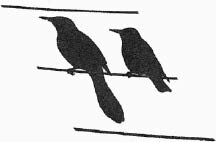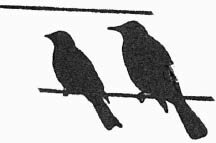
Discover rewarding casino experiences. 

Please Don't Quote Me PART I — Quiscalius quiscalawas, the Latin words attached to the Grackle by the Swedish botanist, Carolus Linneas; words that ask “who,” “what.” As late as 1871 naturalist, John Burroughs called the Grackle “Crow Blackbird uncertain as to kind.” |
Grackles, according to Roger Tory Peterson, artist and bird, flower biographer, clearly listed them in his books writes, “At present the Bronze Grackle is called officially a separate species, distinct from the Purple Grackle. It was long considered a subspecies of the bird and may again be reduced to that rank...” Where the two types mix say in the Appalachians, New York, New England, they are un unofficially called Ridgeways Grackles,” continues Peterson, “because some of us believe it is a mistake to give the two Grackles (Purple/Bronze) full, specific rank.” The blackbirds silhouetted here are from Peterson’s 1956 Field Guide to Birds which is getting pretty ragged from use at our house! You’d hardly think a plain old blackbird would stir up so much question except as a “corn thief,” also one of its names. Such has been a part of its character for a couple of centuries. Naturalist Peter Kalm was sent by the Swedish government to America to explore the New World. When he saw the Grackle he wrote, “They bear in many points so geat a likeness to the daw, the starling and the thrush it is difficult to determine to which genus they belong. Grackles’ common name comes from the Latin word gracula; no, not a cereal type, but the label for the European jack daw, a small crow.
The Swedish immigrants who came here to see the Grackle called it “corn thief” for obvious reasons. Flocks of them settled on the newly plowed earth, robbing it of the crop just planted. The Swedish soon learned to soak the seed in a concoction of the hellebore plant which caused the Grackle to become dizzy and fall over. The prone birds frightened away the Grackles flying about waiting a turn at the field only to be shot, if possible, by the farmer. That method must have been successful to some degree because in 1750 Kalm wrote that there were rarely seen in New England any of the birds. However, there were increases in the corn bore and the cutworm to the dismay of the farmer; “The worms did more mischief than the birds so people repented their enmity.” John James Audubon later said of the Grackle that the corn they took was merely a “tithe.” Many birds we see in our backyards are solitary creatures even among their own kinds, let alone other birds types. The Grackle, however, lives in colonies and defends only a small territory, perhaps as small as a yard around its nest. Red-wing Blackbirds, the bird closest to the Grackle in type, defends its nest aggressively in a much wider territory. Its birdy gestures, however, are much similar to that of the Grackle. Their coloring, of course, identifies it from one another. Sometimes the Grackle will roost with starlings and cowbirds that are so very numerous in rural areas especially cattle yards. In the winter time in the Mississippi Valley it is estimated that as many as fifteen million roost together. Five acres of groves in Kentucky is the site of millions in roost also. In Switzerland in 1950 it was estimated that seventy-two million roosted in two pine forests. How so many survive is a puzzle. You may see the Common Grackle carrying long strands of grass or such material for nest-building. That nest may not be the one it finally lays its eggs in. A diversion? Both female and male carry those materials but the female finishes it off with fine, downy grass for the incubation period of twelve days that she does all by herself. There may be no fledgling phase for the baby Grackle, meaning that it needs no flight training. The parent feeds the juvenile only a couple days after it leaves the nest and then it goes off to join its counterparts, flocking up and roosting as Grackles so love to do. Boat-tail Grackles are a foot or more in length, a large bird. The name comes from the shape of the tail ... Like the keel of a boat from when boats were more prominent in our lives. There’s the Purple, Bronze and Rusty Grackle each having a distinctive beautiful iridescent sheen to its feathers, shimmering as it struts about the lawn. The female is much smaller and is brownish in color; drab. Among the blackbirds in our natural history of Northwest Illinois is the Red-Wing Blackbird that we all recognize for the red and yellow eapaulets it sports on its wing, on the shoulder, as if militarily important. It is a leader of units of their kind in spring, it being among the earliest of birds to come back from the South. The females and year-old yung’uns don’t come for another couple weeks. The males also lead in taking off for parts unknown for their annual molt, late July to early September. Flocks of them seem to disappear for the deep meadow, the damp ditch, or preferably, swampy bog where they like to nest to do the molt-thing; shed all their feathers. They do return to the utility wires, the roadsides, the back lawn where we so often see them but they will soon flock up to organize for the migration to other climates per tradition. The rather aloof blackbird has many interseting ways. If the Redwing of Swedish Lapland is any relation to our American version, it too does a unique thing in laying its eggs every twenty hours, exactly. It’s believed that the rapid succession of egg laying is to take advantage of the daylight in the short summers of the northland. Other birds have specialized egg-laying habits such as the Short-tailed Shearwater which spends its winters in the North Pacific and summers at the Bass Straits near Australia. It habitually lays its eggs in two days either side of November 25. Interesting. Some ornithologists speculate that many birds lay their eggs in dark hours before the dawn in order that the eggshell hardens so as to protect the bird about to be hatched. If its about to be hatched, wouldn’t a soft shell be as good? It’s about to be hatched anyway!
Mama Grackle does all the incubation in the Grackle factory though Pa helps with the feeding. The eggs are laid in some density of vegetation for protection. When danger nears Ma bird flies straight up, “checking, checking” loudly while the male flutters wildly to scare you or other birds, predators off. Watch out! The eggs are incubated for only eleven days and perhaps mama teaches the babes the rules of Red Wingdom for only a week or so and then they go off to do what Red-Wings do so well like swaying prettily on a roadside cat tail, a sight that is so memorable in our rural countryside. When the Red-Wings come, we realize that spring is about to burst. They migrate both North and South with Cowbirds, Starlings and a Robin or two and other birds in the hundreds of swooping formations that so gracefully ribbon the sky with their black designs and dotted design. Watch for the black birds. And read about a few more next week.
|





